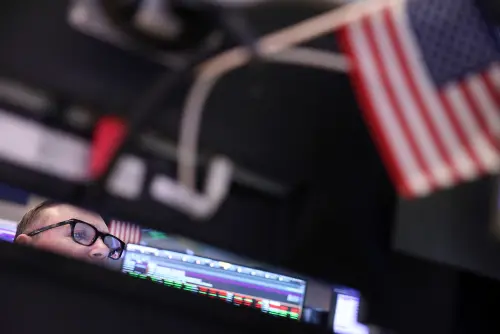What matters in U.S. and global markets today
The market is on track for its best quarter since 1986, underscoring what has been a grim quarter for Wall Street. April offers little hope for improvement, as a turbulent start looms.
Here are the market details alongside rising concerns in the U.S.:
Today's Market Minute
* Trump announced this weekend that the reciprocal tariffs set to be revealed this week will affect all nations. * Gold is positioned for its largest quarterly gain since 1986, as investors flock to safe-haven assets. * Trump expressed his anger towards Russian President Vladimir Putin, threatening to impose secondary tariffs of 25% to 50% on buyers of Russian oil. * Toyota buyers are facing long delivery waits for their new vehicles. * Elon Musk distributed million-dollar checks to two voters in Wisconsin and hinted at smaller payments for others who assist in electoral efforts.
No quarter for Wall Street
Market sentiment remained shaky, exacerbated by geopolitical tensions that resurfaced over the weekend. Stocks worldwide saw significant declines on the last day of March. Japan's Nikkei index fell by 4%, marking its largest single-day drop since September, while South Korea's Kospi dropped 3%.
The S&P 500 is headed for its worst month since 2022 and its worst first quarter since the onset of the pandemic in 2020, with futures suggesting further losses on Monday.
The White House is expected to announce its full tariff plan on Wednesday, but uncertainty about its specifics is high. President Trump's comments over the weekend indicated that all countries could be subject to tariffs, not just the 10 to 15 with the largest trade imbalances. This ambiguity from the administration may create discomfort similar to the actual impact of the tariffs.
On the economic front, disappointing real spending data released on Friday has led to lowered U.S. GDP estimates for the first quarter. The University of Michigan reported an uptick in long-term inflation expectations, while even the gold-adjusted GDPNow model suggests economic contraction during the quarter.
These developments have influenced interest rate expectations, with three Fed rate cuts projected for 2025 now being factored into Fed futures. Two-year Treasury yields that fell below 4% on Friday dropped another 7 basis points on Monday to 3.84%.
Investor confidence regarding future economic and policy direction in the U.S. appears to be diminishing, particularly following Trump's erratic comments on various issues over the weekend. He urged consumers to purchase American-made cars instead of foreign imports, and indicated he was not joking about seeking measures barred by the U.S. Constitution, though he believed it was too early to pursue such actions.
In a geopolitical context, he expressed frustration with Putin regarding stalling on the Ukraine peace deal, threatening further sanctions on nations conducting trade with Russia due to these delays. Markets reacted accordingly, with Wall Street's fear index, the VIX, climbing to its highest level in over two weeks, gold surpassing $3,100 for the first time, and safety-driven investments pushing up the Japanese yen.
Although European stocks have performed well this year with gains exceeding 10%, they also experienced declines on Monday, while the euro held its ground against a weaker dollar.
This week is lighter in terms of economic announcements, but significant labor market data is anticipated alongside the tariff announcements.
Concerns about unpredictable U.S. policy are growing, particularly regarding the potential for the dollar to be weaponized in new ways.
Fears of 'coercion' related to dollar dominance
The line between 'transactional' and 'coercive' in U.S. international economic policy may impact the dollar's dominant role in global finance. Historically, the U.S. has used its economic leverage to influence countries perceived as adversaries, but directly threatening traditional allies is a new development.
As trade and military tensions escalate between the U.S. and its closest partners, the term 'coercion' has emerged in discussions about potential extreme pressures from the U.S. The European Union has prepared for such scenarios, implementing mechanisms that safeguard against countries using trade as a political tool.
The EU now has the ability to restrict access to public procurement for firms from nations that exert economic pressure on its members, which could impact U.S. tech companies if Trump's tariff plans move forward.
While typically associated with authoritarian regimes like China or Russia, the notion of "coercion" is significant when applied to long-standing allies. EU President Ursula von der Leyen recently addressed the idea of being prepared for economic coercion in light of U.S. tariff threats.
European leaders are now considering the implications of potentially losing reliance on the dollar, which could lead to contingency planning for future financial stability. This situation highlights the vulnerabilities created by reliance on U.S.-based payment systems, prompting calls for a digital euro to enhance autonomy.
This raises concerns over whether the Federal Reserve can still be counted on as a reliable source of dollar funding during times of market stress. The notion of using the Fed's safety net as a bargaining chip has far-reaching implications. It may create an impression of dollar scarcity in the short term, increasing its exchange rate, while potentially leading foreign investors to reconsider their commitments to U.S. assets long-term.
The discussion surrounding coercion and the Fed's independence has gained prominence, particularly following Trump's actions towards the Federal Communications Commission. Concerns exist that similar actions against Fed Governors could undermine the central bank's independence and credibility.
Economic coercion takes various forms and often reflects differing perceptions. However, with this year's unprecedented actions, it's understandable that contingency plans are being developed to navigate potential worst-case scenarios.
Chart of the day
This year has been difficult for Wall Street, starkly contrasting with rising European defense stocks and surging gold prices. With little hope of a late-quarter reversal, the upcoming tariff announcements could signal the onset of a significant global trade conflict.
Events to watch:
* Chicago Federal Reserve's March business survey * Dallas Fed March manufacturing survey
